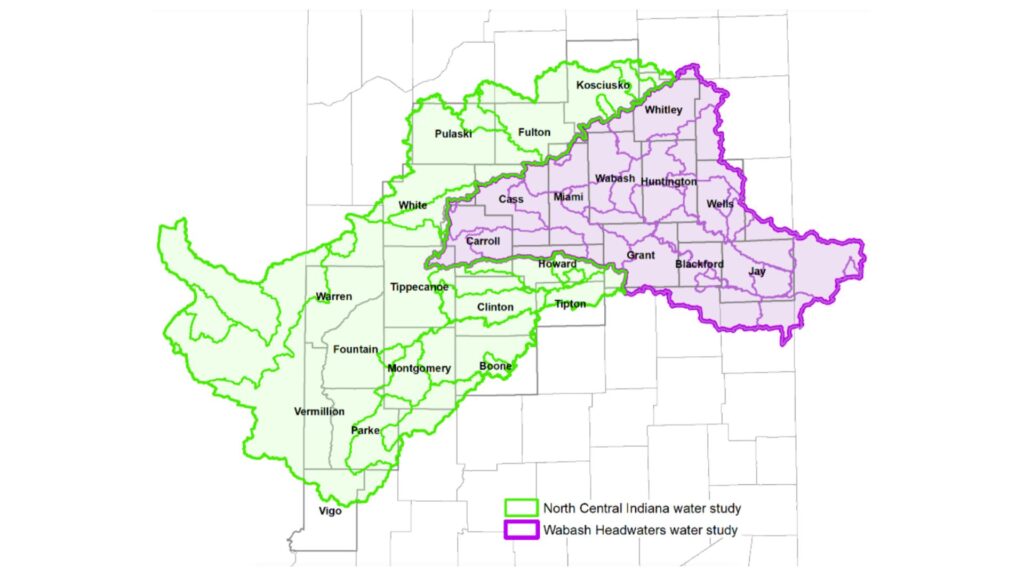The study initially focused on the on upper Wabash River watershed, shown in purple, but was expanded to include its headwaters. (Indiana Finance Authority)
Water withdrawals in the state’s north-central region have dropped — not risen — over the last two decades, the Indiana Finance Authority (IFA) reported Thursday.
The agency, at Gov. Eric Holcomb’s behest, assumed control of an Indiana Economic Development Corp. water study connected to development of a controversial industrial park in November.
IFA Chief Operating Officer and Environmental Programs Director Jim McGoff told board members dated June 20 that the agency’s consultants were “wrapping up” the first half of the 50-year demand and supply study.
“The IFA is committee to providing updates,” McGoff wrote in the letter, “and since the consultants are wrapping up their work on water demand and shifting their focus to supply, we thought this to be an appropriate time to update the IFA Board Members on the progress.”
IFA contracted Stantec Consulting Services and Jacobs Engineering Group for the project.
The study’s initial analysis of the 15-county upper Wabash River watershed includes Boone County, the site of the Limitless Exploration/Advanced Pace Innovation District.
Average water withdrawal in the area was about 770 million gallons per day in 2022, according to McGoff’s letter. Most, 88%, came from surface-water diversions while 12% came from groundwater wells.
Water withdrawals in north-central Indiana over the last 37 years peaked in 2006. (Indiana Finance Authority)
McGoff wrote that total annual water withdrawals increased between 1985 and 2006 by 50%, but have been on the decline since 2006. Now, demand is at 80% of 1985 levels, per the Indiana Department of Natural Resources’ significant water withdrawal facility database.
Much of the decline was in the energy sector, McGoff wrote, but the industry is still responsible for 85% of total water withdrawal. But he noted that energy demand is mostly non-consumptive water use, meaning that most of the water is returned to the river after use.
Public water supply accounts for 6% of the total and other industrial uses represents about 5%. Irrigation and “rural use,” like livestock and fish hatcheries have grown in water use but remain a small share of the total.
IFA in late March announced it would expand the study to include a 10-county area of the Wabash River’s headwaters.
In that area, average water withdrawal in 2022 was about 63 million gallons per day. Most water came from groundwater wells, 63%, while 37% came from surface water diversions.
Total annual water withdrawals increased for the Wabash River’s headwaters between 1985 and 2005 by about 136%, but has declined since 2005, according to McGoff.
When averaged across the entire 1985-2022 period, water use has increased by a modest 29%. He said the energy sector was responsible for “the majority of the variability.”
Industry water demand has grown.
In the Wabash River headwaters area, industrial sector water withdrawals have supplanted energy sector demand. (Indiana Finance Authority)
In 1985, the public water supply sector was the largest water-use category, eating up about 63% of the total, while industry followed at 32%.
In 2022, however, the industrial sector has grown to consume about 47% of the total, while public water supply systems take about 44%.
McGoff noted that between 2007 and 2009, four new industrial facilities began operating in the area.
Agricultural irrigation has also grown, but like in the study’s other region, still represents a small share of total demand.
Memo to IFA Board re Demand (1)
The post North-central water withdrawals in decline, Indiana Finance Authority reports appeared first on Indiana Capital Chronicle.

